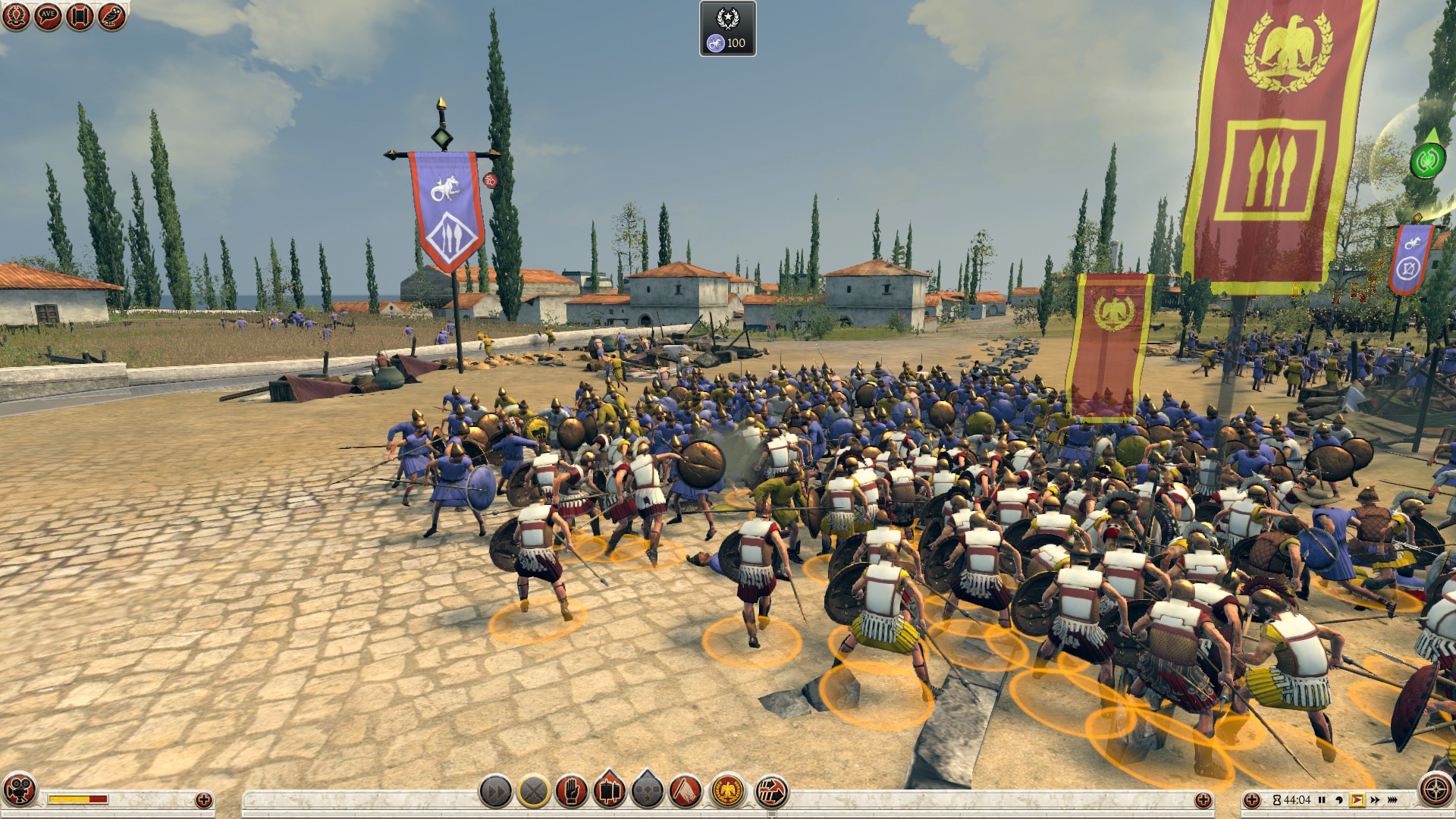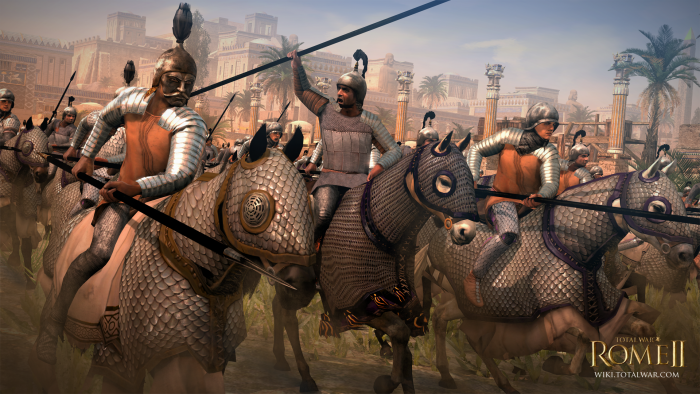Gameplay Trailer :
Name : Total War Rome II
Released : September 2013
Platform : PC
Genre : Strategy
Released : September 2013
Platform : PC
Genre : Strategy
Total War: Rome II is set in the classical antiquity period, and focuses on a more inclusive and in depth portrayal of each culture which previously was portrayed anachronistically. The grand campaign begins in 272 BC, and lasts for 300 years. However, the player also has the option to play further, as there are no timed victory conditions in Rome II.
The Warscape engine powers the visuals of the game and the new unit cameras allows players to focus on individual soldiers on the battlefield, which in itself may contain thousands of combatants at a time. The Creative Assembly has stated that they wish to bring out the more human side of war this way, with soldiers reacting with horror as their comrades get killed around them and officers inspiring their men with heroic speeches before siege towers hit the walls of the enemy city. This is realized using facial animations for individual units, adding a feel of horror and realism to the battles.
Armies and navies have changeable stances on the campaign map. Stances determine factors on the campaign map, such as total movement points per turn or the ability to deploy traps for an ambush. For example, the "Forced March" stance can enable an army to march further, but will also tire out its men and reduce their fighting ability and leave them vulnerable to ambush; the "Defensive Stance" enables the player to place fortifications such as stakes or redoubts, and the "Ambush Stance" enables the placing of traps such as fireballs and sulfur pits. Armies and fleets in Rome II can be made up of a maximum of 20 units and must have a general or admiral to lead them. An individual faction's power, or "imperium", determines the number of armies it can raise. A faction can gain more imperium by conquering more regions and acquiring more gold. Players also have the ability to name units in an army and change their emblems.
When an army is formed, the player must pick a general from a list of available faction members to lead the new army. When it recruits new units, the army enters muster mode and cannot move until the new units have been added to the army. Both armies and generals can gain skills and traits as they level up after a battles. Each skill can be upgraded up to three times to enhance an army or general's performance. Furthermore, if an army loses its general, a new one will be appointed by the player prior to the battle in which the general was lost. These rules also apply to fleets and admirals of the faction's navy.
As with Total War: Shogun 2, the player will be prompted with decisions. The Creative Assembly have expanded on this mechanic, with each decision leading the player down a particular 'decision path' based on the player's previous decisions. These decisions will then affect the way the campaign plays out, such as turning the Roman Republic into the Roman Empire through a civil war. Additionally, rather than solely assigning traits to generals and family members as with previousTotal War games, the player can assign traits to legions as they gain combat experience through their years of conquest. Players can customise legions by choosing their weapon loadout. Players will still be able to determine the composition of individual cohorts, even though they will be building entire legions at a time, unlike in previous Total War titles where the player had to build all units of an army separately.
Navies play an important role in Total War: Rome II. The Creative Assembly introduced mixed naval and land combat for land battles and city sieges. This will reflect the naval strategies of the classical era, where coastal cities were conquered and destroyed by a combination of land and naval power. Legions can attack the enemy's ground forces and cities, while naval units provide supporting fire or engage in naval warfare on the seas. Navies can conquer poorly guarded coastal cities by themselves. In addition, naval combat has been modified to suit the times. Navies are now composed largely of troop carriers, designed to ram and board opposing ships, and land units can now commandeer merchant vessels and embark as makeshift naval units. Naval units were made bigger in size and as a result a player may recruit several naval units at a time allowing construction of a formidable navy more quickly. Naval regions, which were introduced in Medieval: Total War, have returned. Their purpose is to prevent players or the AI from slipping an invasion force right past a huge enemy fleet as in previous titles. Entering a naval region where an enemy fleet is present will trigger a naval combat automatically.
There are three core types of agents in Rome II: the dignitary, the champion and the spy,and each culture will have its own variants for these. When spawned, each agent will have a "profession" that is determined by its supposed background or ethnicity, for example. A player can invest points to an agents profession in addition to its skill tree as the agent levels up. Each agent will be able to assassinate/wound other characters or convert them to join the cause of their faction. This is to make each agent type as useful as possible, but naturally different agents will have different skills and purposes only they can fulfil. When an agent is asked to perform a certain task, there is a deeper set of choices on how to complete the task. For example, when getting rid of an enemy agent, one can bribe him, convert him or murder him.
Developer The Creative Assembly have tried to ensure the uniqueness of different cultures and fighting forces in the ancient times. Lead unit designer Jack Lusted stated that instead of the "rebel nation" of the original Rome: Total War representing minor states, there are a large number of smaller, individual nations and city states represented by their own faction. Each ethnic group have a unique play-style. A tribe of British barbarians looks and feels completely different from that of a disciplined Roman legion, for example. Different agents and technologies are implemented for different factions. There are over 500 different land units in the game, including mercenaries, who have made a return from Rome II 's predecessor. Also, over 30 different city variants are implemented to avoid siege battles feeling and playing out the same every time.
In addition to the traditional sieges and field battles, a myriad of battle types are available in Rome II. These battle types include the following:
Combined naval/land battles: These battles occur when assaulting a coastal city, or when two armies are near the coastline. In the case of the latter, navies can arrive by sea to bolster the land forces with their marines.
Settlement outskirts battles: These battles are fought near regional capitals, which are too small to have walls. In these battles the primary objective is to capture the city rather than destroy or rout the enemy army, although victory can still be achieved by routing your opponent.
Siege battles: These battles occur when an army assaults a provincial capital or a fortified settlement. In these battles, the cities include multiple capture points which the defender has to defend in order to win the fight, as seen in the Siege of Carthage trailer. The attacker can build siege equipment in preparation of the assault.
Encampment battles: These battles are triggered when an army attacks another that is in defensive stance. The defending army has had time to build fortifications around its perimeter, including wooden palisades or small forts. All in all, the battle will resemble a small scale siege.
River battles: River battles are fought when an army tries to cross a major, navigable river and another army tries to stop it from doing so. Navies can aid in this fight, although armies will be able to build transport ships of their own when crossing rivers.
Ambushes: Ambushes have been revamped in Rome II, and feel completely different from before. The ambushing army has the ability to place traps, such as flaming boulders, spikes and so on. The defending army must find a way to escape the siege area to win, although it can also attempt to destroy the ambushing army. These battles will be similar to the battle of Teutoburg Forest historical battle.
Port sieges: Another combined land and naval battle type, port sieges are triggered when a navy sails into an enemy coastal city with a port. The navy will attempt to land its marines in the city, while heavier ships intercept any enemy vessels and provide supporting fire to the marines using catapults and other projectiles, like in the Siege of Carthage historical battle.
The diplomacy system is revamped with a new artificial intelligence, so players can plan their way to power diplomatically. The Creative Assembly has acknowledged the various anomalies in previous games, where the AI could perform strange or even suicidal actions, such as small factions declaring war on the Roman Empire. This has been looked into in the sequel and the AI is said to be more "intelligent" and cunning than ever. The player's own actions during the campaign will determine whether or not the enemy AI will be a trustworthy ally or a suspicious traitor.
The political system of Rome II has been completely remade. The factions of Rome and Carthage each have three political entities that vie for power inside those factions. Players will choose to be part of one of the entities once they select the faction they want to play. Other factions have internal politics between a single ruling family and a class of nobles. The political standing of different entities is based on a resource system, that is in turn based on the deeds and actions of generals and characters belonging to a certain political entity. If one's standing drops too low, they may find himself powerless to affect his nation's affairs, or if one becomes too powerful, rivals might unite against him. In certain cases, a player can attempt to take all power for himself, thus becoming emperor or king. This requires a civil war, however, another part of the game completely redesigned by The Creative Assembly.
Generals can now be both military leaders and skilled politicians, depending on their traits and skill trees.
Minimum Spec
OS: Windows XP/Vista/7/8
Processor: Intel Dual Core 2Ghz
Memory: 2GB
Hard disk space: 35GB
VGA: 512MB Directx compatible







Don't forget to share on this below,
we really appreciate your support :
we really appreciate your support :

0 komentar :
Post a Comment